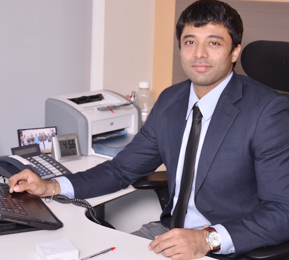Paul S Parampreet has an overall experience of over 7 years. He has previously worked with Edelweiss Securities Pvt. Ltd. in the asset management function, SDG India Pvt. Ltd., ICICI Bank and BG India Pvt. Ltd. He has experience in long short equity trading, quantitative trading strategies, probabilistic and deterministic analysis. He has a PGDM from the Indian Institute of Management, Calcutta and Bachelor’s degree in Electrical Engineering from IIT Kharagpur.

1. After scaling the 20,000 the BSE Sensex has once again dropped to 19,000 levels within a short period. What is your take on this market movement, and what should investors expect in the near term?
Ans: We expect markets to be volatile going ahead. This volatility is driven by the risk on/risk off environment that has been in place for a couple of years now. Based on expectations of QE tapering which are in turn shaped by economic data – the general expectation is that the market is likely to be range bound within 5500 to 6100 on the Nifty Index.
2. How does a small asset size impact investment decisions in fund management? Are there any benefits to a smaller asset size?
Ans: As quantitative strategies used by Edelweiss Asset Management Limited (EAML) are adaptive in nature, they are agnostic of the asset size of the scheme or AUM. EAML deploys a well diversified portfolio in most of its schemes, thereby spreading investment amount among a larger number (usually 40 to 60) of stocks.
Usually, funds with smaller asset size can choose to select a few good bets in the portfolio to outperform the benchmark. However, as the AUM of such schemes increases, the liquidity constraints will require them to select a more diversified portfolio. This in turn is likely to adversely affect the performance.
3. What do you expect from Q1FY14 earnings season? Has the market priced in the earnings improvement following the recent rate cuts? Or do you expect earnings to surprise and hence leave room for a rally?
Ans: We expect consumer, pharma, IT, telecom and utilities sectors to post higher earnings. We expect decline in the earnings of metals & mining, cement, infrastructure and automobile sector. The overall expectation from Q1FY14 earnings is muted. We expect the top line to grow in the range of 2% to 4% and the bottom line to stay flat or decline marginally in the range of -3% to 0% for the Nifty Index companies.
4. How do the sector weights across the schemes managed by you differ? E.g. You are bullish on Banks and FMCG across equity funds, but the weights differ, could you explain what determines these differences?
Ans: The weight of a particular sector in a scheme is tethered to the benchmark and the mandate of the scheme. For example, in a large cap scheme with Nifty Index as benchmark, the weights for individual sectors will be within a certain range (+- x%) of their weight in the benchmark. Similarly for a mid cap scheme with a relevant mid cap benchmark, the sector weights will be tethered to that benchmark.
5. The equity allocation in the Edelweiss Absolute Return Fund has reduced considerably in the current month and cash levels have been increased? Do you see higher valuations now?
Ans: Edelweiss Absolute Return Fund’s objective is to generate absolute returns with low volatility over a longer tenure of time. On a shorter time horizon, the scheme endeavors to deliver maximum upside participation over a twelve month period when Nifty Index is positive while reducing the downside participation over a twelve month period when Nifty Index is negative. To meet this endeavor, the scheme uses dynamic hedging strategy in order to protect the downside and avoid market volatility at times. These changes are made on a daily basis and hence are not based on valuations but mostly dependent upon the market price action.
In terms of market valuations, we expect Nifty Index to continue to trade at a slight discount to its long term average. This is primarily due to lower returns on equity for most companies when compared with their longer term averages.
6. Edelweiss D.G.E Top 100 Fund has performed well in the short and long run. What strategy do you attribute to the fund’s good performance, being market conditions unfavorable?
Ans: As mentioned earlier, EAML uses an adaptive quantitative approach to portfolio management. We call it an ABCD approach – Adaptive multifactor strategies which endeavor to Beat the market Consistently with Diversified portfolio.
The approach uses a bottom up stock selection methodology. It ranks stocks on the basis of quantitative factors like growth, valuation, consistency, quality, volatility and liquidity. The selected stocks are then combined into a portfolio on the basis of expected volatility environment, risk constraints and correlation among the stocks. Expectations of a high volatility environment lead to a defensive portfolio selection and vice versa. Thus portfolios are suited for the environment in which they are being deployed. This helps in the endeavor to deliver consistent outperformance over time.
7.What strategy would you suggest the investor to adopt at this point of time in the market?
Ans: As mentioned above, we expect the markets to be volatile going ahead. Also, growth is going to be scarce in this environment and thereby growing companies are likely to attract large valuation premiums.
We would advise conservative investors to look for products which provide downside protection. For investors with a more aggressive approach, we would like to suggest funds which have bias towards growth and quality in their stock selection.


